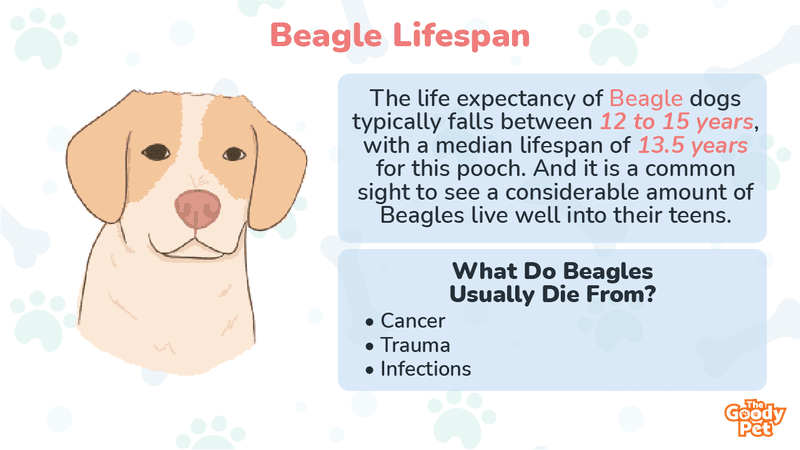Beagles are one of the more common dog breeds around, and knowledge of this pooch’s health issues is paramount to successfully owning and maintaining one of these wonderful dogs.
Now, what are the common health issues that Beagles face? Health issues that Beagles typically experience during their lifetimes include fatal cancer, infections, cataracts, cherry eye and allergies, among others. If left unattended, these health issues can greatly reduce a Beagle’s life quality and considerably shorten the pooch’s lifespan.
Beagles are typically expected to stick around for a fairly long time, hence proper care and maintenance is necessary to ensure that the pooch enjoys the best life possible. Detailed information on a Beagle’s dietary and physical needs, and how to cater for the aforementioned is contained in this article. But before we delve into that, let’s see exactly how long you can expect your Beagle to be around for.
What Is The Lifespan Of A Beagle?
The life expectancy of Beagle dogs typically falls between 12 to 15 years, with a median lifespan of 13.5 years for this pooch. And it is a common sight to see a considerable amount of Beagles live well into their teens.
When compared with the lifespan of dogs within the same size range, and all other dog breeds in general, the lifespan of Beagles falls within the upper echelons of the age bracket for dogs.
Similarly, the age range specified for Beagles is just an estimation, and it is quite possible for Beagles to live well beyond 15 years, while some other pooches from this breed may not even make it to their tenth year birthdays. Ultimately, how long a Beagle will stay alive for is dependent on several factors, some of which include:
Size
A research journal, published by the American Naturalist in 2013, has established a general fact that small to medium-sized dogs tend to outlive their larger counterparts. And the Beagle, being a medium-sized pooch is generally favored by this widely accepted fact.
However, if you overfeed your Beagle and allow it to grow grossly overweight, you can expect the pooch to develop several weight-related issues that can significantly shorten the pooch’s lifespan.
Genes
Genes also play a major role in deciding a Beagle’s lifespan, and you can expect a pooch that has inherited good traits from its parents to lead a long and healthy life.
Conversely, Beagles whose parents were prone to suffering from several health conditions are at a high risk of inheriting these conditions, and this can cut back a significant amount on the pooch’s expected lifespan.
Quality Of Care
Having good genes is one thing, but the quality of care that a Beagle receives during its life will determine how long and healthy the pooch’s life will be.
That said, Beagles that receive the best medical attention, are fed appropriately nutritious meals and are frequently exercised, have a higher chance of leading longer, healthier lives. In contrast, Beagles, when raised in toxic environments and with little regard for their welfare, are at a higher risk of dying early.

What Do Beagles Usually Die From?
The common causes of death in Beagles include:
Cancer
As is the case for the majority of the dog breeds, cancer is the leading cause of death in Beagles, especially among adult male and female pooches of this breed.
Studies estimate that cancer is responsible for approximately 23% of Beagle deaths per year, with the most common occurrences including skin tumors, mast cell tumors, bone cancer and cancer of the lymphocytes (blood cells).
Infections
Another major cause of Beagle deaths, particularly among puppies, is any of the several infections that this pooch is prone to suffering from.
Parvovirus, in particular, is one infection that is common among Beagle puppies, and with a considerably high fatality rate at that. Other infections that tend to claim the lives of Beagles include canine distemper, leptospirosis and several other bacterial infections.
Trauma
While this can’t be completely classed as a medical condition, a significant number of Beagles – both young and old – succumb to various forms of injuries resulting from avoidable accidents on a yearly basis.
Studies have indicated that trauma is responsible for approximately 16% of adult Beagle deaths per year. And given their small and frail stature, this cause of death is typically more predominant among Beagle puppies.
What Other Health Conditions Do Beagles Suffer From?
Apart from the potentially fatal diseases explained above, Beagles are prone to suffering from eye problems such as cataracts, glaucoma and cherry eye, which typically cause the pooch’s eyesight to worsen, and in some cases, total blindness.
And in the same vein, Beagles have long, flappy ears, and it is this physical feature that makes this dog breed prone to suffering from ear infections.
The list of medical conditions that Beagles are known to suffer from also includes:
- Hypothyroidism
- Intervertebral Disk Disease
- Pulmonic Stenosis
- Wobbler’s syndrome
- Diabetes
- Allergies

How Do You Know If Your Beagle Is Dying?
Death is a painful aspect that all dog owners will, at one point or the other, have to deal with, and we all wish that our furry friends can live forever.
However, by accepting that your Beagle will, one day, draw its last breath, and the ability to spot the signs that a pooch is nearing to the end of its life will enable you to make preparations that ensure the pooch is as comfortable as possible in its final days.
That said, some of the symptoms commonly exhibited by dying Beagles include:
Loss Of Appetite
One of the first and most commonly observed signs that a Beagle is dying is a loss of appetite for both food and water.
Dying Beagles typically tend to consume less food and water than they used to, and in some cases, it is possible for the pooch to stop eating and drinking altogether.
What Can You Do To Help?
- Consult with your vet to prescribe the use of appetite stimulants for your Beagle
- You can also feed the pooch smaller meals at closer intervals
Loss Of Weight
As a consequence of the pooch’s failure to eat, a dying beagle will typically experience either a rapid or gradual loss of weight, along with a corresponding wastage of body muscle.
What Can You Do To Help?
- Since a dying Beagle’s weight loss is closely linked to the pooch’s failure to eat, getting the pooch to eat will mostly resolve this issue.
- You can also consult your vet to draw up a special meal plan to combat your Beagle’s severe weight loss
Social Withdrawal
As a Beagle’s final days on earth draw nearer, the pooch will typically begin to detach itself from its daily routines and seek solitude in quiet areas of the home.
What Can You Do To Help?
- Respect the pooch’s desire for solitude
- Speak to the dog in calm, gentle tones, if you must
Reduced Mobility
Another telltale sign that a Beagle is dying is a reduction in mobility, due to the pooch losing strength to get up and move about. Beagles are naturally active animals; Hence, when your pooch spends most of the day lounging lazily on its bed, you should know that something’s up.
What Can You Do To Help?
- Provide non-skid flooring to enable your Beagle move around without issues
- Gently carry your Beagle around if you must move the pooch
Incontinence
Dying aged Beagles typically lose control over their bladder muscles, and coupled with the pooch’s inability to move around and use the toilet, there’ll typically be an increase in the occurrence of bathroom accidents.
What Can You Do To Help?
- Place special sanitary pads under itself Beagle
- Clean up messes as soon as the Beagle soils itself

How To Take Better Care Of Your Beagle?
Feed Your Pooch An Appropriate Diet
Beagles are an active and energetic dog breed, and to ensure that these pooches’ energy requirements are met, it is recommended that you feed a protein-rich diet with a low to moderate level of healthy fats and carbohydrates.
And regardless of whether or not you’re feeding your Beagle with homemade meals or a manufactured diet, you should ensure that the protein content is gotten from quality animal-based sources such as turkey, chicken or beef.
The most common type of manufactured diets fed to Beagles is dry kibble, but wet food can come in quite handy in providing nutrition to a Beagle that refuses to drink water. And if you’re making the choice to go with wet food as the source of your Beagle’s nutrition, one of the best products on the market that will facilitate healthy growth and development in your pooch is the Pet Plate diet.
The Pet Plate diet is formulated with fresh, healthy ingredients in the exact proportion that is needed to ensure proper physical development in Beagles. And these ingredients found in the Pet Plate diet are also food substances that dogs love eating, thereby eliminating pickiness among Beagles.
How Much Should You Feed Your Beagle?
Generally, growing puppy Beagles need to consume 55 calories per pound of body on a daily basis. And as the Beagle grows to become an adult, the calorie requirement typically drops to between 42 to 45 calories per pound of body weight.
How Often Should A Beagle Be Fed?
Beagle puppies below two months of age that have been weaned should be free-fed. But once the pooch clocks two months, its meals should be reduced to four servings per day.
Beagles aged between five months to one year will do well on three meals a day. And once the pooch becomes an adult (one year and above), it should be fed just two times daily.
Exercise Your Beagle Regularly
Proper, regular exercise can significantly extend your Beagle’s lifespan, and this is one part of your pooch’s routine that shouldn’t be joked with.
Most Beagles enjoy running around, and will get a significant amount of exercise when they’re allowed to play. However, to complement exercise obtained from allowing a Beagle to run around, it is recommended that you take this pooch on walks, once or twice daily.
You should also take the time to engage your Beagle in interactive games such as fetch, and tug-of-war as they afford the Beagle an opportunity to develop mentally and also learn some basic commands.

Related Questions
What Is The Longest Living Beagle? The record for the longest living Beagle belongs to an American pooch named Butch that lived for an incredible 27 years! Butch was born in 1975 and died in the year 2003, having lived most of his life in Virginia, USA. It is also worth noting that Butch has an entry in the Guinness Book of World Records as the second longest living dog ever!
Is It Better To Have 1 Or 2 Beagles? Beagles do extremely well in pairs, and it is definitely better to have two Beagles in one household. And not only will both Beagles keep each other entertained, but they will also keep each other company, when their owner is away, thereby helping to prevent separation anxiety.
What Do Beagles Hate? Beagles hate sudden, loud noises, and they absolutely detest being left alone at home for a considerable period. Some beagles also hate visits to the vets, and it isn’t uncommon to see Beagles cowering at the sight of an unfamiliar face or object.





